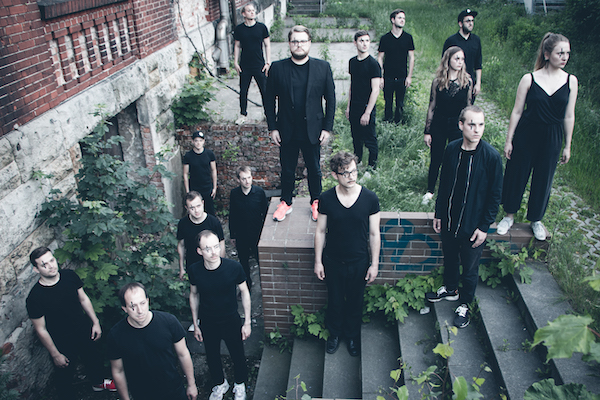Oct 28, 2025 10:47 AM
In Memoriam: Jack DeJohnette, 1942–2025
Jack DeJohnette, a bold and resourceful drummer and NEA Jazz Master who forged a unique vocabulary on the kit over his…

The influence of Count Basie sits alongside ideas gleaned from German DJs on Dancing Wittgenstein (ACT), the latest album from Munich’s Jazzrausch Bigband.
(Photo: Josy Friebel)Jazzrausch Bigband’s mix of jazz and techno initially might seem surprising, even in this era of cross-genre pollination. But as the group’s main composer and arranger Leonhard Kuhn explains, the band’s music actually makes perfect sense.
Big bands of the 1920s played music people danced to, and “nowadays dance music is electronic dance music or techno,” he said recently. “Today’s dancehalls are techno clubs.”
“Rausch” in German signifies a “rush or high” triggered by excessive drinking or drug use, and its presence in the band’s name reflects the musicians’ belief that those feelings can be summoned by jazz. The group’s semi-regular sets at Munich’s Harry Klein club, which notched a mention in a DJ Mag poll of the world’s best venues a few years back, is an indication the Jazzrausch Bigband’s pastiche is being embraced by fans deeply engaged with electronic music.
“This is a very special thing,” said the ensemble’s trombonist Roman Sladek while discussing shows at the venue. “It’s important for us to be in a place where techno is played throughout the night, to get that vibe and make it a real working crossover project.”
Contrasting with both the dance-floor and jazz influences, the band’s most recent album, Dancing Wittgenstein (ACT), continues earlier nods to Austro-German high culture—Beethoven and Bruckner among them—through its quirky title, while maintaining an international focus. Unlike the more subdued Prague Calling from 2015, however, Wittgenstein is a visceral affair, notwithstanding the title track being inspired by Kuhn’s reading of Ludwig Wittgenstein’s Tractatus Logico-Philosophicus, a 1921 work on the relation between language and reality. Kuhn explained that the title cut enacts the philosopher’s idea that experience can exist outside of language through the refrain “Do you feel like ...,” a chorus that’s left hanging, but punctuated by some shredding guitar and unison horn lines.
Many of the album’s songs extend past the eight-minute mark and are accompanied by a pounding beat, at times making any pure jazz influence difficult to parse. Yet, it’s there, the musicians insist, highlighted in solos, most often by Sladek’s trombone.
Averaging more than 100 shows annually—with past stops at Nairobi’s Safaricom International Jazz Festival, Shanghai’s JZ Festival, SXSW in Austin, Texas, and a show at New York’s Lincoln Center—the traveling has come to bear on Jazzrausch’s expansive line-up. Typically, an ensemble from the classic big-band period would number in the dozens, Kuhn posits. Jazzrausch, though, needed to prune back instrumentation because of touring logistics. More than 40 players make up the jazz orchestra, but the line-up on the road generally tops out at about 15 players, with horns (trumpets, trombones, tuba, alto and soprano saxophones, two tenors, baritone and bass saxophone, bass and contra bass clarinet), a rhythm section (guitar, synthesizer, electric bass, drummer), vocalists and Kuhn providing electronic percussion via a laptop and Ableton.
“You can’t really do voicing with two trumpets, but with this style of music I’m not thinking so much in terms of chord voicing, but rhythmical patterns and mixing sounds,” said Kuhn.
Enter the emphasis on Sladek’s trombone, which also has led to an interesting deepening of the ensemble’s connection to techno. The trombone has a “good sound” for the music, Sladek said: “You can use it as a kind of synthesizer without transforming the sound too much. When you put a delay on it, it is closer to a traditional techno synthesizer sound than maybe a trumpet or saxophone.”
With all those live dates each year, Jazzrausch Bigband has become renowned for high-voltage performances. Yet, within the party atmosphere, there’s still plenty of experimentation going on. Kuhn’s introduction of electronic drum sounds transfers an “authentic techno value” to the music, even as all other instruments are played acoustically.
Count Basie, French composer André Hodeir and the free influence of the ’70s and ’80s NDR Big Bands, sit alongside ideas gleaned from German DJs like Stephan Bodzin and Rødhåd, according to Kuhn. But what Jazzrausch Bigband is aiming for, he continued, is music that pushes both jazz and the “techno aesthetic” beyond expected conventions.
“[Our music] is not techno, it’s not jazz,” Kuhn concluded. “It’s something unique and new. It’s music you can listen to and dance to at the same time.” DB

Jack DeJohnette boasted a musical resume that was as long as it was fearsome.
Oct 28, 2025 10:47 AM
Jack DeJohnette, a bold and resourceful drummer and NEA Jazz Master who forged a unique vocabulary on the kit over his…

Always a sharp dresser, Farnsworth wears a pocket square given to him by trumpeter Art Farmer. “You need to look good if you want to hang around me,” Farmer told him.
Sep 23, 2025 11:12 AM
When he was 12 years old, the hard-swinging veteran drummer Joe Farnsworth had a fateful encounter with his idol Max…

D’Angelo achieved commercial and critical success experimenting with a fusion of jazz, funk, soul, R&B and hip-hop.
Oct 14, 2025 1:47 PM
D’Angelo, a Grammy-winning R&B and neo-soul singer, guitarist and pianist who exerted a profound influence on 21st…

Kandace Springs channeled Shirley Horn’s deliberate phrasing and sublime self-accompaniment during her set at this year’s Pittsburgh International Jazz Festival.
Sep 30, 2025 12:28 PM
Janis Burley, the Pittsburgh International Jazz Festival’s founder and artistic director, did not, as might be…

Jim McNeely’s singular body of work had a profound and lasting influence on many of today’s top jazz composers in the U.S. and in Europe.
Oct 7, 2025 3:40 PM
Pianist Jim McNeely, one of the most distinguished large ensemble jazz composers of his generation, died Sept. 26 at…